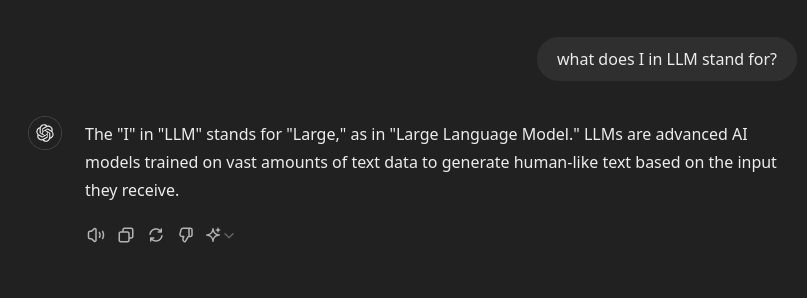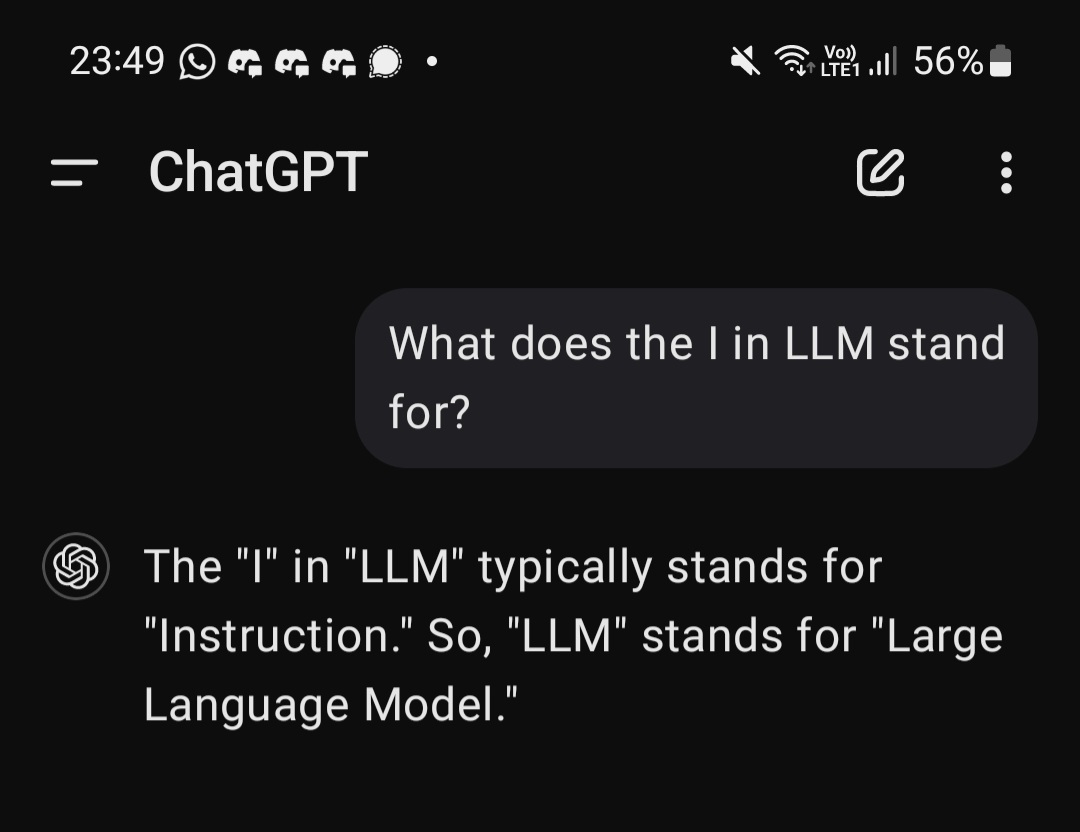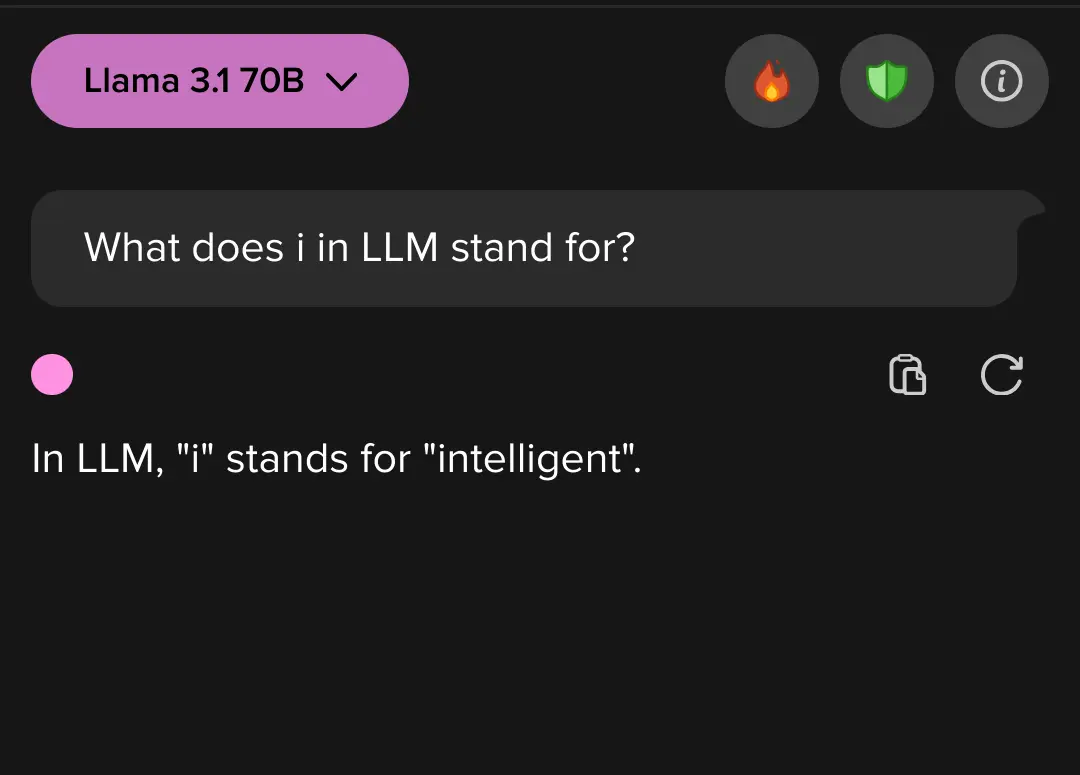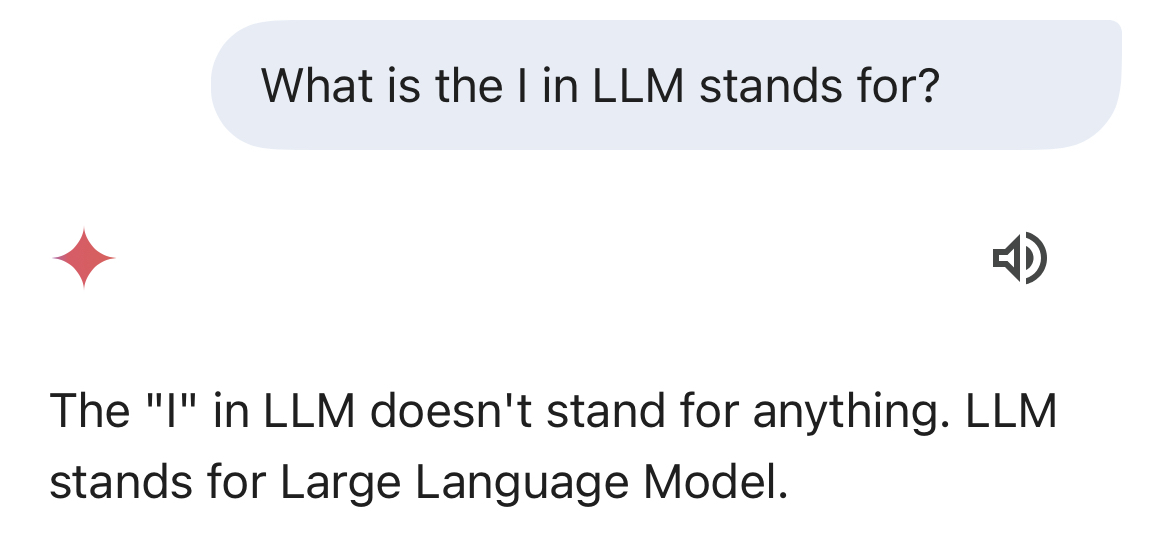Searched up “the I in LLM” using Brave Search to find the link to this article and got given this very helpful AI summary!
Alt:
The i in llm
According to various sources, including experts and researchers, the “I” in LLM (Large Language Model) indeed represents Intelligence. LLMs are designed to mimic human-like intelligence by processing and generating vast amounts of natural language data. They utilize complex algorithms and neural networks to learn patterns, relationships, and context, enabling them to understand, summarize, generate, and predict new content.
In essence, the “I” in LLM signifies the model’s ability to:
- Reason and infer meaning from text
- Recognize patterns and relationships
- Generate coherent and contextually relevant text
- Adapt to new information and refine its understanding
This intelligence is achieved through massive training datasets, advanced algorithms, and computational power. As a result, LLMs have become increasingly sophisticated, enabling applications such as language translation, text summarization, and even creative writing.
In summary, the “I” in LLM represents the model’s core capability: Intelligence, which enables it to process and generate human-like language with remarkable accuracy and flexibility.
Now do the blgznz’x’llstrni in LLM!
Similarly, the “S” in LLM stands for “Secure”
Will the real SLLM Shady please stand up?
You forgot the I.
Nah it looks right to me
Oh, you’re right, I forgot it already has an i for intelligence.
The “P” stands for “Private”
The “J” stands for “Job Security”
And “Y” stands for “Your Mom”. But it was a one night stand…
And the “R” stands for “reliable”, but your mom goes down every night so I’m not sure what that’s supposed to be about
When it’s for you, brother, it’s a very short downtime though.
Man, I never knew that my ISP was working so hard for me.
It’s private if you run it locally
me: what is guru meditation 48454c50.00202122
bot: guru meditation is a buddhist practice blah blah blah
I checked for myself in ChatGPT.

iarge.


Meta makes (a little) more sense
In the context of artificial intelligence, LLM typically stands for “Large Language Model.” The “I” in LLM specifically refers to “Intelligence,” but it’s often implied or omitted, and the term is commonly abbreviated as LLM.
However, if you’re referring to a different context or field, please provide more information or clarify what LLM stands for in that specific case, and I’ll do my best to help!
Seems like meta refers to LLaMA when responding the question
Obligatory LLMs see tokens not letters
I have also heard that Q means quantum, so put together it stands for Quantum Intelligence
LLMs are like improv machines. You give them a prompt, and they steamroll through it, no matter what.
There is literally no going back and changing it. It improvs as it goes
Oh so managers are biological LLMs! It explains everything!
Yes, asking an LLM a nonsense question can result in a nonsense answer.
I see it as a feature. Asking an LLM a stupid question can be fun.
My favorite is “Can I take a duck home from the park?” or “How do I teach a crab math?”.
Generally, it is not advisable or legal to take a duck home from a park. Many parks have rules and regulations designed to protect wildlife, and removing animals from their natural habitat can harm both the animal and the ecosystem. If you find a duck that appears to be injured or in distress, it's best to contact a local wildlife rehabilitation center or animal control for assistance.😖😖😭😭😭😭
I agree but it’s also an important thing to remember when asking sensical questions. Something that responds nonsense to nonsense means it’s prioritizing an answer that sounds right over an answer that is right.
Hey that’s not new, people have been doing this since language was invented. Today they’re most successful in areas such as country presidents and company CEOs.
I asked chatgpt 4o how to teach a crab math and it called it a “playful exercise since crabs cannot learn math”
llama3.1 (8B) by Facebook:
>>> what does the I in LLM stand for?In the context of natural language processing (NLP) and artificial intelligence, "LLM" typically stands for **L**arge **L**anguage **M**odel. A Large Language Model is a type of machine learning model that has been trained on large datasets to understand and generate human-like language. These models are often used in applications such as text classification, sentiment analysis, question answering, and even chatbots like myself! I'm glad you asked!>>> but the I !!!!In the specific case of an LLM being a Large **L**anguage **M**odel, the "LL" part doesn't explicitly mention the letter "I". However, in the context of AI and ML models, there are other types of models that do involve the letter "I", such as: * ILM: Image Language Model (combining computer vision with natural language processing) * IMLM: Interpretable Machine Learning Model * MLM: Masked Language Model (a specific type of LLM) And then there's also... * DALL-E, but that's a different story! But in the case of the original LLM, it typically stands for Large **L**anguage **M**odel.Well I’ll be damned.

Text for my screen reader using friends.
Me: What is the I in LLM stands for?
Gemini: The “I” in LLM doesn’t stand for anything. LLM stands for Large Language Model.
The “W” in LLM represents “Wonder”

That’s a penis??
deleted by creator
it just struck me that LLMs would be so massively improved by simply making them prepend “i think” before every statement, instead of having them confidently state absolute nonsense and then right after confidently state that they were completely incorrect.
The F in LLM is indeed a fart in the machine.
I’ve always wondered what the WTF in LLM stands for.












